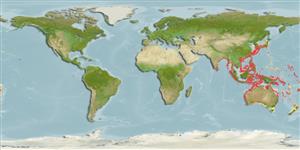Teleostei (teleosts) >
Holocentriformes (Squirrelfishes, soldierfishes) >
Holocentridae (Squirrelfishes, soldierfishes) > Myripristinae
Etymology: Ostichthys: Greek,osteon = bone + Greek, ichthys = fish (Ref. 45335).
More on author: Cuvier.
Environment: milieu / climate zone / depth range / distribution range
Ecology
Marine; reef-associated; depth range 90 - 240 m (Ref. 114923). Tropical
Indo-Pacific: from the Andaman Sea to the Philippines; north to southern Japan, south to Australia, east to New Caledonia, Fiji, Tuvalu, and Vanuatu;
Size / Weight / Age
Maturity: Lm ? range ? - ? cm
Max length : 45.0 cm TL male/unsexed; (Ref. 2272); common length : 35.0 cm TL male/unsexed; (Ref. 9137)
Dorsal spines (total): 12. This species is distinguished by the following characters: 3½ scales above lateral line to midbase of spinous portion of dorsal fin; spineless at anterior end of nasal bone of adults or subadults; no large spine at the corner of preoperculum of adults (subadults may have a small spine at angle); 28-30 lateral-line scales (usually 28, rarely 30); D XII; space between last dorsal-fin spine and first dorsal-fin ray notably less than space between last two dorsal-fin spines; pectoral-fin rays 15-17 (usually 17, rarely 15); height of second suborbital bone below center of eye ½ eye diameter; last dorsal-fin spine distinctly longer than penultimate spine; prepelvic scales 9; dorsal profile of head nearly uniformly convex; gill rakers 7-10 + 12-14; depth of body 2.05-2.2 in SL; head length 2.35-2.5 in SL; snout short, 4.65-5.6 in HL; least depth of caudal peduncle 4.0-4.5 in HL; colour when fresh overall reddish, edges of scales red, the centers silvery pink (Ref. 114923).
Found in the sublittoral zone (Ref. 11230).
Life cycle and mating behavior
Maturities | Reproduction | Spawnings | Egg(s) | Fecundities | Larvae
Greenfield, D.W., J.E. Randall and P.N. Psomadakis, 2017. A review of the soldierfish genus Ostichthys (Beryciformes: Holocentridae), with descriptions of two new species in Myanmar. J. Ocean Sci. Found. 26:1-33. (Ref. 114923)
IUCN Red List Status (Ref. 130435)
Threat to humans
Harmless
Human uses
Fisheries: commercial
Tools
Special reports
Download XML
Internet sources
Estimates based on models
Preferred temperature (Ref.
123201): 18.3 - 29, mean 27.7 °C (based on 2088 cells).
Phylogenetic diversity index (Ref.
82804): PD
50 = 0.5001 [Uniqueness, from 0.5 = low to 2.0 = high].
Bayesian length-weight: a=0.01778 (0.00680 - 0.04650), b=3.02 (2.79 - 3.25), in cm total length, based on LWR estimates for this (Sub)family-body shape (Ref.
93245).
Trophic level (Ref.
69278): 4.0 ±0.66 se; based on food items.
Resilience (Ref.
120179): Medium, minimum population doubling time 1.4 - 4.4 years (Preliminary K or Fecundity.).
Fishing Vulnerability (Ref.
59153): Low to moderate vulnerability (35 of 100).
Nutrients (Ref.
124155): Calcium = 33.4 [14.5, 164.9] mg/100g; Iron = 0.5 [0.2, 1.1] mg/100g; Protein = 18.3 [17.0, 19.7] %; Omega3 = 0.139 [0.055, 0.364] g/100g; Selenium = 50.5 [26.9, 104.4] μg/100g; VitaminA = 43 [12, 166] μg/100g; Zinc = 0.815 [0.499, 1.300] mg/100g (wet weight);
